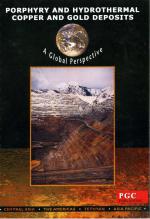Добрый день, Коллеги. Важное сообщение, просьба принять участие. Музей Ферсмана ищет помощь для реставрационных работ в помещении. Подробности по ссылке
Porphyry and hydrothermal copper and gold deposits. A global perspective / Порфировые и гидротермальные месторождения меди и золота. Глобальные перспективы
Abstract - Hydrothermal copper & gold deposits associated with felsic intrusives, particularly porphyry related and epithermal ores, are found in a series of extensive, narrow, linear metallogenic provinces throughout the world. These are predominantly associated with the great Mesozoic to Cainozoic orogenic belts. Major deposits however, are also found within Palaeozoic orogens, while a few are known from the Precambrian. The style and setting of these deposits is variable and diverse, although many common features emerge from a global comparison.
Contributions on major new discoveries, mines and lesser known important deposits from more remote locations make up this conference. They are equally divided among the four most important of the great orogenic belts that embrace porphyry and other hydrothermal Cu and Au deposits around the world, namely the Cordillera of the Americas, the Asia-Pacific, the Tethyan Belt and Central Asia.
This paper provides a global context to those contributions by discussing and comparing the distribution and characteristics of each of these orogenic belts and their mineral deposits, both geologically and geographically. It also discusses the progress made this century in understanding the porphyry orebodies in particular, and the importance of comparing deposits from around the world to better understand the potential and possibilities for major new discoveries and developments.
Hydrothermal copper and gold, particularly porphyry orebodies, are among the most significant in the world from the viewpoint of size and/or grade. They are the basis of some of the world's largest mining operations and are the cornerstone of many of the worlds great mining houses. As such, they are an important target for many companies.The aim of this conference is to provide a global overview of new developments relating to these deposits around the world, looking at the common factors and the contrasts that are emerging to provide a better appreciation of the exploration and development possibilities.To this end, the conference includes papers on major new discoveries, new mines brought into production and newly emerging provinces, but also on the more established great copper and gold deposits of central and southern Asia and eastern Europe, for which, until recently, information has been less accessible. The main emphasis is on case histories of discovery and on descriptive geology, supported by economic and commercial detail, directed principally towards, and presented by, industry geologists.Although we have learned a lot about these deposits, our understanding is far from complete. It is hoped that this conference will incrementally advance that understanding.The mining history of porphyry copper and gold orebodies, and to a lesser degree of bulk gold deposits, commenced more of less with the 20th century. In the latter years of the 19th century a number of organisations around the world entertained the concept of bulk mining low grade ores, mainly in response to declining grades as the limited high grade tonnages remaining struggled to accommodate world demand.The first successful bulk mining operation however, was by Utah Copper in 1905 at Bingham Canyon in the US. This was not a reflection of the discovery of a deposit, but rather the engineering ability to mine on a large scale at low cost, and simultaneously to metallurgically recover the copper at the same rate by the flotation process (Gilmour, et. al. 1995), which had only recently been developed in Australia.Within 10 to 15 years, several other famous porphyry copper deposits were successfully brought into production with grades of 1 to 2% Cu. Many of them, like Bingham Canyon, are still operating today. Over the next 50 years around 20 significant mines recognised as porphyry copper and copper-molybdenum deposits were developed, all within the US "Southwest" and in northern Chile and neighbouring southern Peru. With the exception of Bingham Canyon, none were significant gold producers. Many were only economic on the basis of their oxide caps or supergene blankets, developed over low grade (0.25 to 0.5% Cu) primary mineralisation (Gilmour, et. al. 1995).Right up to the 1960's there was an acceptance by many, that porphyry copper deposits were restricted to Laramide age (late Cretaceous to early Tertiary) porphyritic texture "granitic" intrusive associations, and were localised in the US "South-west" and northern Chile to southern Peru, and were Cu-Mo orebodies (Gilmour, et. al. 1995). All were within continental and continent margin settings.In the meantime deposits, not then recognised as porphyry systems, were being discovered and mined elsewhere in the world. These included the gold and gold-copper ores of the Baguio and Lepanto-Mankayan districts in the Philippines, which commenced operation in the mid 1930's, but were associated with more intermediate intrusives believed to be late Tertiary in age. During the same period the great Central Asian Palaeozoic deposits of the Soviet Union were outlined, of which the outside world new little. Both of these examples had little influence on thinking on porphyry systems, as they were precluded from the knowledge base.During the 1950's and 60's however, with political instability and uncertainty growing in Africa, the other great copper producing region, new sources of copper were sought. As a consequence, the focus began to broaden and spread away from the Americas, with exploration for porphyry copper mineralisation commencing both in Australia and in Canada, while the recognition of the nature of the deposits in the Philippines spurred acquisition and exploration there. Most of the Philippines deposits did not have the tonnage or grade of the classic deposits, were molybdenum poor and gold rich, and were spatially associated with epithermal gold mineralisation. The exceptions included the important Atlas and Sipalay Cu-Mo orebodies which were broad analogues of the "South-west" US deposits. <...>




